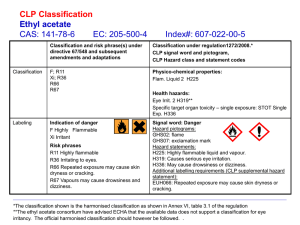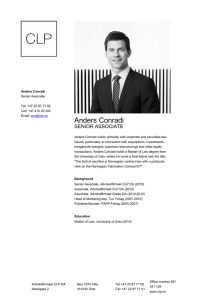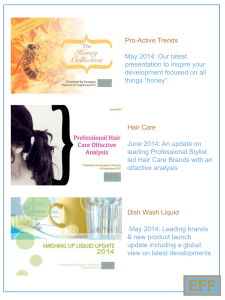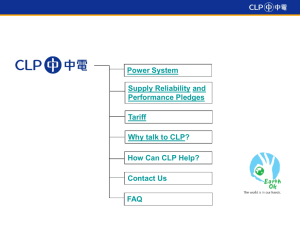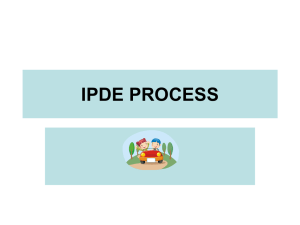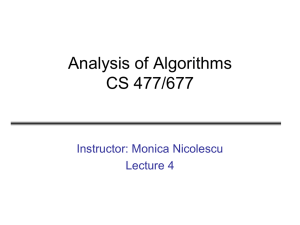EU`s Classification, Labeling and Packaging Regulations (CLP)
advertisement
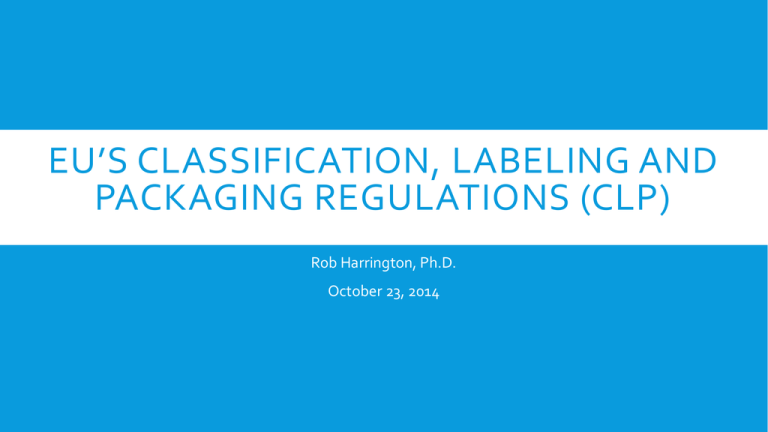
EU’S CLASSIFICATION, LABELING AND PACKAGING REGULATIONS (CLP) Rob Harrington, Ph.D. October 23, 2014 CLP REGULATION EU Regulation (EC) No 1272/2008 on Classification, Labelling and Packaging entered into force on 20 January 2009 It replaces the Dangerous Substances Directive and the Dangerous Preparations Directive There is a transitional period 2010 –2015 during which time both classification systems may be used for mixtures It is the European implementation of UN Globally Harmonized System (GHS) of classification WHY DEVELOP A GLOBALLY HARMONIZED SYSTEM (GHS)? Companies around the world are major importers/exporters of chemicals Missing, contradictory or incomplete information on chemicals may lead to reduced protections for workers and public. Large number of varying requirements around the world create confusion, shipping issues and potential barriers to trade A harmonized and consistent approach has benefits both in terms of protection and trade. GHS PROJECT: INTERNATIONAL MANDATE The goal of establishing a globally harmonized system for hazard communication was established in 1992 at the UN Conference on the Environment and Development - “Rio Earth Summit”. The Mandate: “A globally harmonized hazard classification and compatible labelling system, including national safety data sheets and easily understandable symbols, should be available, if feasible, by the year 2000.” NEED FOR HARMONIZATION EXAMPLE: CAFFINE LD:50 = 260 mg/kg GHS Acute Toxicity Category 3 U.S. , Canada, Japan - TOXIC Australia, Malaysia, EU - HARMFUL India - NON-TOXIC China - NON-HAZARDOUS U.N. PURPLE BOOK – THE BASIS FOR GHS CLP GHS IMPLEMENTATION TIMELINE For substances, CLP classification and labeling was required as of December 2010 For mixtures, CLP classification and labeling was optional as of January 2009: during the transitional phase either may be used As of June 2015, CLP labeling will be mandatory on all consumer and workplace products sold in the EU A 2-year sell through time will be allowed for products manufactured before June 2015 OVERVIEW Hazard classification: Provides specific criteria for classification of health and physical hazards of substances as well as mixtures. Labels: Chemical manufacturers and importers will be required to provide a label that includes a harmonized signal word, pictogram, and hazard statement for each hazard class and category. Precautionary statements must also be provided. BASIC ELEMENTS OF GHS Classification Criteria - each substance /mixture needs to be classified for: Health and environmental hazards Physical hazards Hazard Communication - apply the results of the classification process to: Labels Safety Data Sheets CLASSIFICATION "Classification" means to: identify the relevant data regarding the hazards of a chemical review data to ascertain the hazards associated with the chemical decide whether the chemical will be classified as hazardous according to the definition of hazardous chemical Hazard classification is a self-classification process – manufactures and importers must classify each chemical/mixture, determine the appropriate hazard class and category based on the evaluation of full range of available data/evidence No testing is required CLASSIFICATION Classifications are based on specific and typically complex procedures outlined in the regulations. Data is gathered on the substance/mixture and compared to the criteria on the standard The resulting classification is used to determine the proper labeling requirements HEALTH/ENVIRONMENTAL HAZARD CATEGORIES Acute Toxicity Skin Corrosion/Irritation Serious Eye Damage/Eye Irritation Respiratory or Skin Sensitization Germ Cell Mutagenicity Carcinogenicity Reproductive Toxicity Target Organ Systemic Toxicity – Single and Repeated Dose Aspiration Toxicity Hazardous to the Aquatic Environment PHYSICAL HAZARDS Explosive Flammability – gases, aerosols, liquids, solids Oxidizer – liquid, solid, gases Self-Reactive Pyrophoric – liquids, solids Self-Heating Organic Peroxides Corrosive to Metals Gases Under Pressure Water-Activated Flammable Gases CLP REQUIRED LABEL ELEMENTS Product identifier Hazard pictograms Signal words (Warning or Danger) Hazard statements Precautionary information Supplier identifier (name, address, phone) Net contents Supplemental information is optional Pictograms HEALTH HAZARD FLAME EXCLAMATION MARK GAS CYLINDER FLAME OVER CIRCLE CORROSION ENVIRONMENT EXPLODING BOMB SKULL & CROSSBONES • Acute Toxicity (fatal or toxic) • Acute toxicity (harmful) • Eye or skin irritant • Skin sensitizer • Respiratory tract irritant • Narcotic effects • Hazardous to the ozone layer • Corrosive to skin • Eye damage • Corrosive to metals • Flammable • Pyrophoric • Self-heating • Emits flammable gas • Self-reactive • Organic peroxide • Oxidizer • Gases under pressure • Explosive • Self-reactive • Organic peroxide • • • • • • Carcinogen Mutagen Reproductive toxicity Respiratory sensitizer Target organ toxicity Aspiration toxicity • Aquatic Toxicity Categories of Acute Oral Toxicity Category 1 LD50 < 5 mg/kg Category 2 Category 3 Category 4 LD50 > 5 to < 50 mg/kg LD50 > 50 to < 300 mg/kg LD50 > 300 to < 2000 mg/kg DANGER DANGER DANGER WARNING H300 Fatal if swallowed H300 Fatal if swallowed H301 Toxic if swallowed H302 Harmful if swallowed CANDLES AND CLP In 2008, the EU authorities were asked to decide if candles were mixtures or articles under CLP and the EU REACH regulation If candles are articles, then they are exempt from CLP labeling If candles are mixtures, then they must be classified and labeled under CLP Candles were determined to be “mixtures” under CLP and not articles by a ruling of the European Commission LABELING OF CANDLES UNDER CLP Classification involves determining if the composition of the product triggers any health, environmental or physical hazard and labeling the product based on the results Ingredients like waxes are non-hazardous and do not contribute to the classification Some additives may be hazardous and if present at a high enough concentration, could require warning statements or pictograms Many fragrances ingredients are known eye/skin irritants, skin sensitizers or are environmentally hazardous substances; if present at concentrations above the cut-off values, they trigger health or environmental warning statements and/or pictograms ISSUES WITH FRAGRANCES THAT ARE SENSITIZERS If a candle contains any sensitizing fragrance ingredient at more than 0.1%, the label should bear the statement “Contains (name of fragrance(s)). May produce an allergic reaction.” If a candle contains more than a total of 1% sensitizing fragrance ingredients, it should bear the exclamation point pictogram, the signal word WARNING, and have the statement “May cause an allergic skin reaction” and list some ingredients. The greater the concentration of fragrance in the candle, the more likely that it will trigger one or more of these warnings. ISSUES WITH FRAGRANCES THAT ARE ENVIRONMENTALLY HAZARDOUS MATERIALS Several fragrance ingredients are very toxic to aquatic life. Determining the need for an environmentally hazardous warning in mixtures can be very complex. Calculations must be done to see if the fragrance ingredients exceed the threshold for labeling The greater the concentration of fragrance in the candle, the more likely that it will trigger an environmental warning. EXAMPLE Pillar candle with a fairly high fragrance load Contains fragrance materials that include several skin sensitizers that trigger a skin sensitization warning statement and pictogram Contains a fragrance carrier that exceeds the trigger for a hazardous to the environment warning statement and pictogram Not classified under any other hazard category CLP LABELING FOR SKIN SENSTITZER SIGNAL WORD: WARNING HAZARD STATEMENT: May cause an allergic skin reaction Prevention Statements Response Statements Avoid breathing dust/fume/gas/mist/spray/vapor (recommended if inhalation is possible) Contaminated work clothing should not be allowed out of workplace (not for general public) IF ON SKIN: Wash with plenty of soap and water. (recommended for consumers) If skin irritation or rash occurs: Get medical attention. (recommended) CLP LABELING FOR HAZARDOUS TO THE ENVIRONMENT SIGNAL WORD: None HAZARD STATEMENT: Toxic to aquatic life with long lasting effects Prevention Statements Response Statements Avoid release to the environment (Recommended unless this is the intended use) Collect spillage (Recommended) DETERMINATION OF LABELING STATEMENTS Label statements should be chosen based on the results of the classification process Due to the nature of the product, some of the statements may not be appropriate There may be options to eliminate some of the warnings under appropriate circumstances Following the CLP labeling regulations labels may result in warnings that raises consumer concerns UNFRAGRANCED PILLAR CANDLE PRODUCT IDENTIFIER EU CANDLE PICTOGRAMS NOT CLP Directions: xxxxxxxxxxxxxxxxxxxxxxxxxxxxx (optional) National Candle Company, Somewhere, Someplace, UK 44-131-555-5555 Made in the USA X cm x Y cm NET CONTENTS COMPANY INFORMATION CITRUS PILLAR CANDLE PRODUCT IDENTIFIER PICTOGRAMS WARNING SIGNAL WORD May cause an allergic skin reaction. HAZARD STATEMENT Toxic to aquatic life with long lasting effects. HAZARD STATEMENT Avoid breathing vapor. IF ON SKIN: Wash with plenty of soap and water. If skin irritation or rash occurs: Get medical attention. Keep out of the reach of children. PRECAUTIONARY STATEMENTS Contains: XXXXXX, XXXXX, XXXX Directions: xxxxxxxxxxxxxxxxxxxxxxxxxxxxx (optional) National Candle Company, Somewhere, Someplace, UK 44-131-555-5555 Made in the USA X cm x Y cm NET CONTENTS COMPANY INFORMATION CLP LABELING EXEMPTION? Currently there are discussions going on in the EU that may result in an exemption for irritant/sensitizing/environmental warnings on candles The Association of European Candle Makers (AECM) and the European Candle Association (ECA) are working on this issue Self-executing exemptions are also possible OTHER CONSUMER PRODUCTS Many consumer products will undergo labeling changes based on the new CLP regulation Products formerly classified as non-hazardous may suddenly be reclassified to a hazardous category Companies may choose to reformulate or eliminate the use of some ingredients to avoid labeling Many air freshener products will be impacted by CLP Many possible changes to come as the new regulation comes into force EU REACH REGULATION REACH stands for the Registration, Evaluation, Authorization and Restriction of Chemicals It is Europe’s version of the EPA Toxic Substance Control Act (TSCA) It requires non-EU companies importing substances into the EU to “pre-register” then “register” any individual substance (even if it is a mixture) if it is shipped into the EU at more than 1,000 kg/yr. Failure to “pre-register” substances that are being shipped into the EU will result in immediate denial or entry of shipments into the EU and monetary penalties EU REACH REGULATION Non-EU companies must obtain a legal representative in the EU to register the substances they import on their behalf; this allows continued imports without restriction through 2018 Companies are required to join consortiums of companies shipping the same chemical (s) into the EU to complete the registration of the chemical By 2018, the consortiums should fully every substance for the EU and will allow imports indefinitely. EU SAFETY DATA SHEETS - 16 SECTION 1. Identification 2. Hazard(s) identification 3. Composition/information on ingredients 4. First-aid measures 5. Fire-fighting measures 6. Accidental release measures 7. Handling and storage 8. Exposure control/personal protection SAFETY DATA SHEETS - 16 SECTION 9. Physical and chemical properties 10. Stability and reactivity 11. Toxicological information 12. Ecological information 13. Disposal considerations 14. Transport information 15. Regulatory information 16. Other information FOR MORE INFORMATION Full Text of CLP Regulation http://eur-lex.europa.eu/LexUriServ/LexUriServ.do?uri=OJ:L:2008:353:0001:1355:EN:PDF Guidance Document on CLP Labelling http://echa.europa.eu/documents/10162/13562/clp_labelling_en.pdf CLP Guidance Website http://echa.europa.eu/guidance-documents/guidance-on-clp For additional questions: Rob Harrington, Ph.D. 630-222-7624 robmharr@gmail.com
